Why Your Pet Food SEO Strategy Will Fail Without Long Tail Keywords (Grab Your Downloadable Keyword Planner Worksheet)
by
Jeremy Tang - Updated
01-Oct-2024
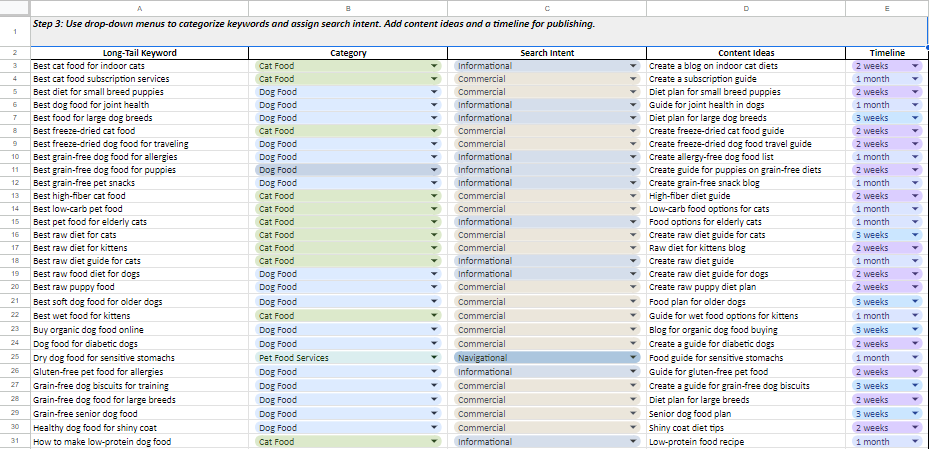
Long tail keywords are essential for your pet food SEO strategy, driving higher-intent traffic and improving conversions by focusing on specific, niche search terms. With Area Ten, you can efficiently scale content creation and stay ahead of competitors, leading to significant gains in organic traffic and revenue.
Long tail keywords are specific, multi-word search queries that people type when they’re looking for something unique.
While each one may not have a ton of search volume, together, they make up around 90% of search opportunities.
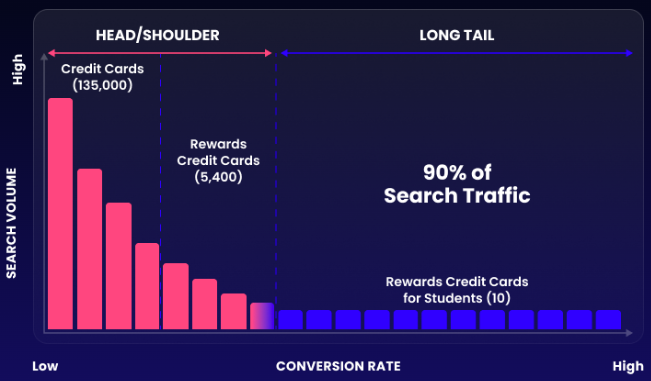
Standing out in a crowded online market is tough, but a good pet food SEO strategy can make the difference between thriving and being invisible to potential customers.
Think of your site gaining a lot more organic traffic, and those clicks actually turning into sales. That sounds great, but most pet food retailers can only imagine getting such results.
The reason? A single-minded focus on broad, competitive keywords.
These keywords are definitely important, but here’s the thing—devoting all your resources to targeting them is not always the best move. Instead, a niche strategy centered around long tail keywords could be what ends up driving significant results. These specific, multi-word search queries address precise customer needs and boast lower competition, making them a goldmine for any savvy business owner.
Ignoring these opportunities means losing out to competitors who have mastered this approach, resulting in missed traffic and revenue.
There are thousands of unique, niche terms your pet food store could target, allowing you to tap into a diverse and engaged audience. When used effectively, long tail keywords can help you catch the attention of people who are looking for specific products—the products that you’re selling—increasing the likelihood that they’ll become paying customers.
Instead of battling it out with big brands over the high-competition keywords (like “pet food”), you can focus on specific searches where there’s less competition but more intent. It’s a smart way to meet your customers where they are and serve their exact needs.
Our client, a US-based pet food e-commerce platform offering a huge variety of pet food for all sorts of animals, found itself stuck when it came to SEO.
Despite offering everything from affordable options to premium, specialty diets, and treats, the store struggled to gain visibility online. They were missing out on potential customers actively searching for niche pet products, and this was becoming a major issue affecting their bottom line.
By mid-2022, they were failing to attract the right audience. While pet owners were searching for niche products like “grain-free cat food” or “organic dog treats,” the store’s SEO strategy focused on high-competition, broad keywords such as “best dog food” and “cat food.” These terms were dominated by big-budget competitors with stronger domain authority, making it nearly impossible for a smaller player like this to compete.
Here’s how it unfolded.
Broad Keywords, Low Results
Over a period of four months, the company invested $12,000 in SEO efforts targeting these highly competitive, broad search terms. Despite these efforts, their rankings barely improved, with less than a 5% increase in overall visibility. Worse, the traffic they did manage to generate was largely low-intent, resulting in a minimal conversion rate of just 0.6%.
Traffic vs. Sales
The few visitors who did click through were not their ideal customers. This low-quality traffic didn’t convert, leading to a drop in sales. To quantify the impact:
Before the SEO Campaign:
After Four Months of the SEO Campaign:
Wasted Resources
The misguided SEO strategy drained not only their marketing budget but also their time and potential revenue. The $12,000 investment in SEO services, coupled with a decline in conversions, led to substantial financial losses over the four-month period.
Let’s break it down.
Total Revenue Loss Over Four Months:
Total SEO Expenditure Over Four Months:
Total Financial Loss Over Four Months:
By the time the company realized they needed better SEO services, they had already lost significant revenue and time.
If this story sounds familiar, we’ve outlined the key reasons why your pet food SEO strategy fails without long tail keywords—and how leveraging these specific search terms can dramatically improve your SEO performance.
Pet owners these days are more mindful than ever about what goes into their pets’ bowls.
In fact, a study found that 43.6% of people care more about buying healthy food for their pets than for themselves (Source: National Library of Medicine). This growing awareness has driven them to start looking for very specific things, like “grain-free dog food” or “raw diet for cats,” rather than just typing in “pet food” and hoping for the best.
Pet owners are digging into product details, reading labels, and checking sourcing because they want to make sure they’re giving their furry family members the best. Because of the specificity of their intent, broad keyword strategies won’t cut it.
Relying on just generic terms like “dog food” or “cat food” is a big reason your store isn’t being found by the right people.
Imagine setting up a pet food store in a busy city. If you just put up a big sign that says “pet food,” you’re competing with every other store out there with the same generic message. With this approach, you’re essentially hoping that prospective customers will stumble upon you by accident.
This only leads to missed opportunities to connect with high-intent buyers actively searching for exactly what you offer.
But if you also put up smaller signs that say “grain-free dog food for sensitive stomachs” or “organic cat treats for picky eaters,” you’re now speaking directly to the needs of a specific group of customers. These people are way more likely to walk into your store because you’re offering products that line up with their pets’ specific dietary requirements.
Essentially, long tail keywords greatly improve eCommerce SEO for your website in a simple way—they’re the signs that bring the right people to you without having to fight off the competition for attention.
To capture high-intent buyers, you need to use diet-specific long tail terms.
Start by identifying long tail keywords that align closely with both your products and customer needs. For example, if you offer grain-free dog food or organic cat food, target more precise terms like “best grain-free food for puppies” or “organic food for cats with allergies.”
These specific terms are what pet owners use when they are ready to buy, and optimizing for them ensures your store appears on their screens once they do a search.
General keywords like “best pet food” are incredibly competitive because they are broad and attract massive search volume.
Big brands and huge websites have already staked their claim here with high-authority content, making it harder for smaller businesses to break through. Competing for these terms usually means you need a strong domain authority and a lot of resources, which, let’s be real, can take time and effort—something not everyone has when they’re trying to see quick results in their dog or cat food SEO strategy.
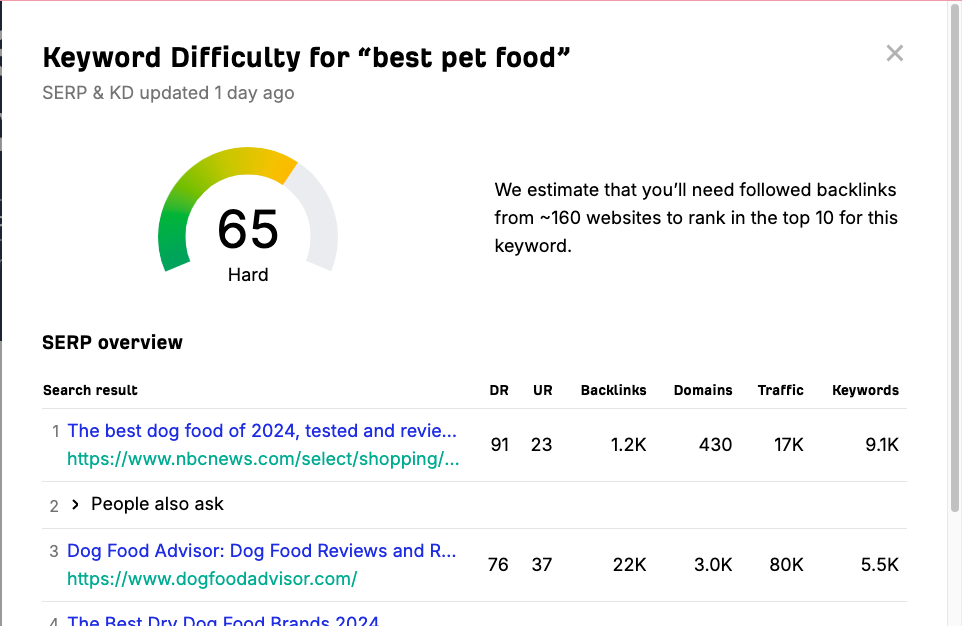
It’s not just about organic competition either. In paid media management, everyone is also fighting for these high-traffic keywords.
If you check out the search results for terms like these, it’s not always pet food stores ranking at the top. More often, it’s high-authority sites posting about pet food trends or health-related articles.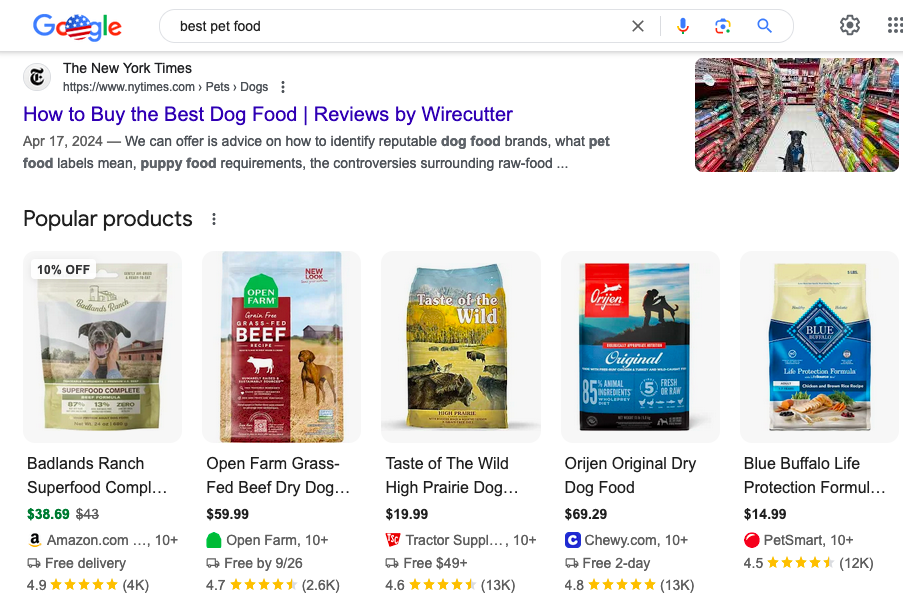
While it’s not impossible to rank for broad, high-traffic keywords, focusing all your time and effort on these head terms limits your overall ranking potential. Just think about it—the energy required to rank for one head term could be used to rank for multiple long tail keywords instead.
If you want a smarter strategy for puppy food SEO or any other type of pet food, the answer is simple. By spreading your efforts across multiple niche keywords, you can see faster results and capture a larger share of the market with less competition.
To boost your rankings and cut through the noise, it’s smart to start focusing on low-competition, high-intent keywords. SEO tools like Ahrefs and SEMrush are perfect for this. These platforms allow you to enter seed keywords (like “grain-free pet food” or “organic cat food”) and uncover related search terms that are less competitive but still drive traffic.
If you’re a beginner in SEO, look at the Keyword Difficulty (KD) score for each term. This shows you how tough it’ll be to rank for that keyword.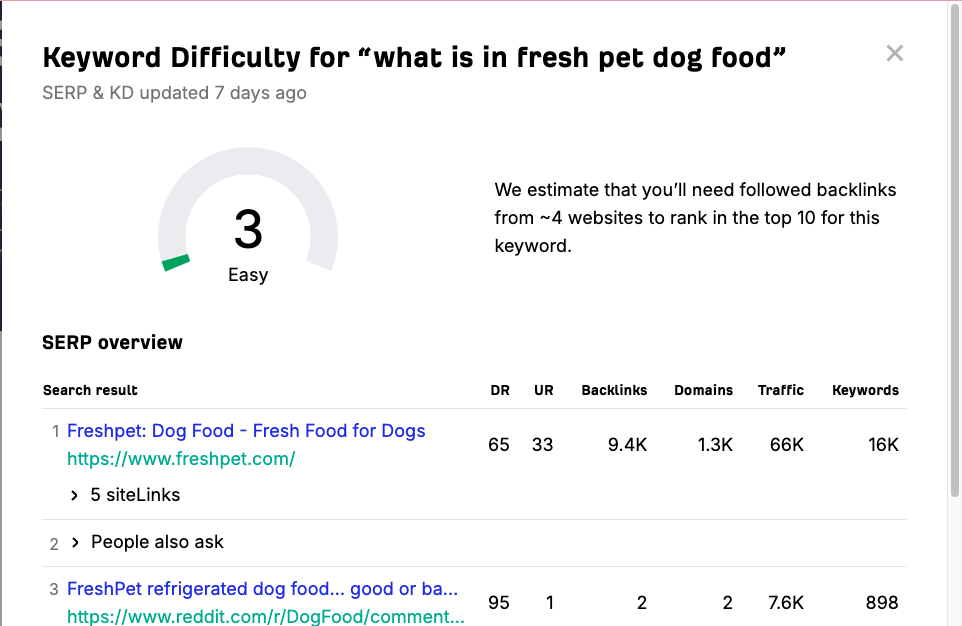
Filter the results to find keywords with low difficulty but relevant traffic. Then, focus on those hidden gems that align perfectly with your store’s pet food categories.
This makes it easier to optimize your content and product pages, giving you quicker SEO wins.
Long tail keywords are a godsend for e-commerce businesses specifically because they have such a high conversion rate. In fact, these terms boast a nearly 25% higher conversion rate than the highest-performing landing pages out there (Source: The Hoth).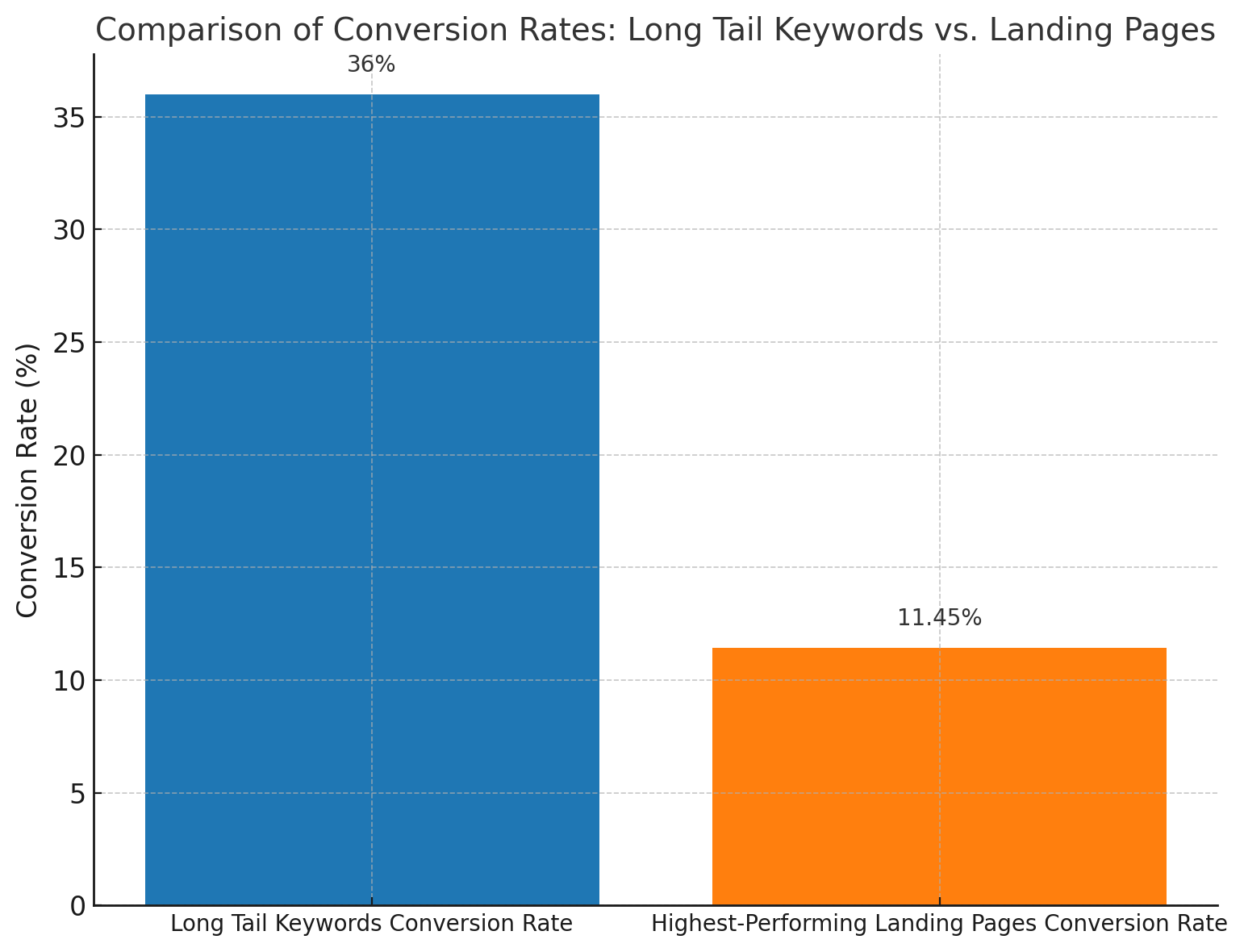
When shoppers use specific terms like “hypoallergenic dog food near me,” they’re basically telling you, “I’m ready to make a purchase, right now.”
When your product page includes specific long tail terms in both the title and description, it sends a clear signal to search engines and shoppers that your product is exactly what they’re looking for.
This makes your page show up higher in search results, and when customers see something that matches their search so perfectly, they’re way more likely to click—and buy. Basically, you’re setting up your content to mirror the search intent of these high-intent users, turning their clicks into sales more effectively.
To boost your conversions, it’s key to match your product descriptions and titles with specific long tail keywords.
Think about what pet owners are really looking for, and make sure your descriptions address those needs.
Make sure to highlight the following information in your product descriptions:
To help you level up your SEO game and transform your strategy, we’ve prepared a helpful long tail keyword planner worksheet that you can use.
Just click this link and make your own copy: Area Ten Long Tail Keyword Planner Worksheet
Here’s the PDF: Long-Tail-Keyword-Planner-Worksheet-Area-Ten.pdf
Here’s how to use it:
Start by brainstorming core keywords that relate directly to your pet food store’s products and services.
Think of the foundational terms your potential customers might use. For instance, if your store specializes in “grain-free dog food,” that’s a strong seed keyword. Other related terms might include “puppy food” or “senior dog food.” These are the starting points for building out your keyword strategy.
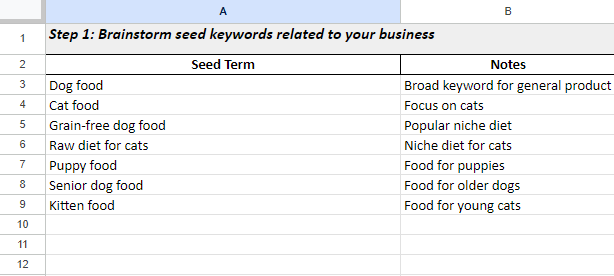
Next, expand on your seed keywords using tools like Semrush or Ahrefs.
Download the data, then filter out any keywords that don’t meet your goals, such as terms tagged with “cheap” or those unrelated to your niche. Focus on keywords with more than four words and enough search volume to make them valuable.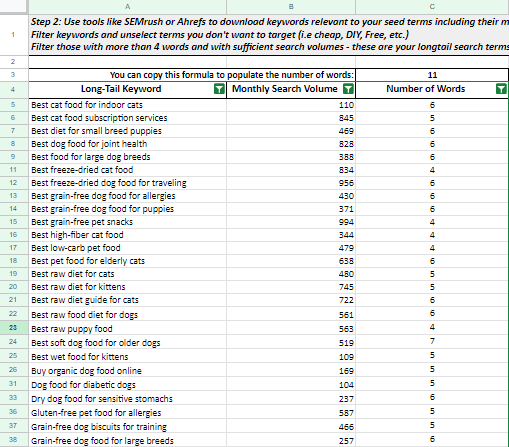
Categorize the keywords based on search intent, such as informational or transactional. This helps clarify what type of content you need to create for each keyword.
Develop content ideas for your prioritized keywords, and set a timeline for publishing these pieces. Prioritize those with higher purchase intent that align closely with your niche offerings.
Consistent tracking of performance metrics is the secret to continued SEO success.
Monitor key indicators such as Click-Through Rate (CTR), organic traffic, and conversion rates for each keyword. Then, use this data to identify what’s working and what needs adjustment. Refining your strategy based on these metrics will help you improve your results continuously.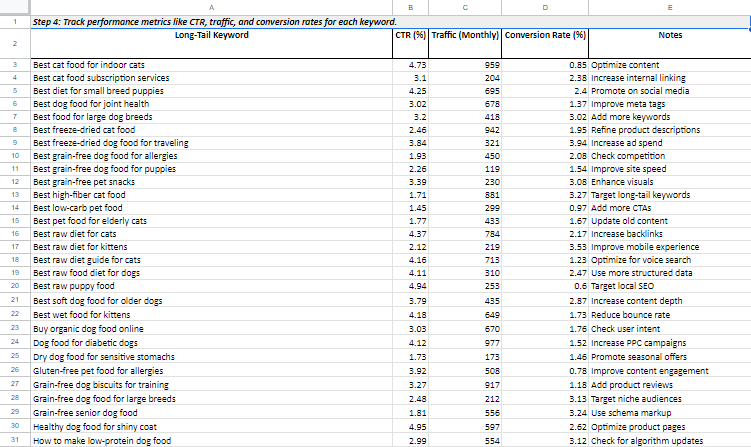
If you’ve already seen success with just a few, think about what could happen when you ramp that up to hundreds or even thousands.
Traditional SEO often feels slow and requires constant manual updates, so it’s not the best approach for this sort of thing. Instead, we at Area Ten use programmatic SEO to handle things at a scale that was once unimaginable—delivering fast results without sacrificing quality.
When it comes to scaling your pet food SEO, CMAX, our proprietary technology for accelerating SEO performance, is the best tool for the job.
Unlike standard approaches that use generic templates or basic AI like ChatGPT, CMAX goes above and beyond. It creates thousands of unique content pieces, each one tailored to match your brand’s personality, comply with industry requirements, and connect with your audience.
Additionally, CMAX features an automated cross-linking logic that enhances your website’s structure and SEO performance. This helps search engines and users to easily navigate and understand your site content.
CMAX is like having a GPS for your SEO.
When we uncover new keywords or trends, our CMAX technology is capable of re-optimizing, much like how a GPS adjusts to roadblocks or traffic. Human insights and intuition guide our data analysis so that all our tools and resources are constantly recalculating your path to success, ensuring your pet food store always ranks for the most relevant and impactful search terms.
With CMAX accelerating your SEO efforts in your marketplace SEO, you can stay ahead of the curve and your competition.
Now that you know just how impactful our long tail keyword strategy can be, let’s go back to our client from earlier. How did things turn out for them?
After their previous SEO efforts didn’t quite hit the mark, this pet food retailer teamed up with our digital marketing agency for a more focused strategy. With a tighter SEO budget, we knew we had to make every dollar count. So, we switched things up by zeroing in on long tail keywords, allowing us to make the most of their budget while still delivering noticeable results.
After just one and a half months, the retailer saw a 36.1% increase in organic traffic and a 22.5% increase in organic revenue—a result their previous agency failed to deliver even after six months of effort.
So, whether you need effective Shopify SEO for your online store or just want a high-quality programmatic strategy in place, you can trust the experts at Area Ten to deliver.
Are you tired of seeing nothing but mediocre results for months on end under your current SEO agency?
At Area Ten, we deliver unparalleled SEO acceleration for businesses of all sizes—from humble start-ups to global enterprises. Want a better SEO or PPC strategy implemented? We drive results that will blow the competition away.
Thanks to our cutting-edge programmatic technology, combined with the expertise of our veteran team, we are able to deliver results 4x faster and at 10x the impact of other SEO companies. If you’re ready to say goodbye to stagnation and welcome scalable growth, inquire about our FREE SEO Fast Track today and find out how we can empower your business.
Book a free video consultation below to see how your SEO & Paid Media campaigns are performing against global benchmarks in your industry.
We’ll uncover tangible opportunities to grow your business in just 6 weeks, including: